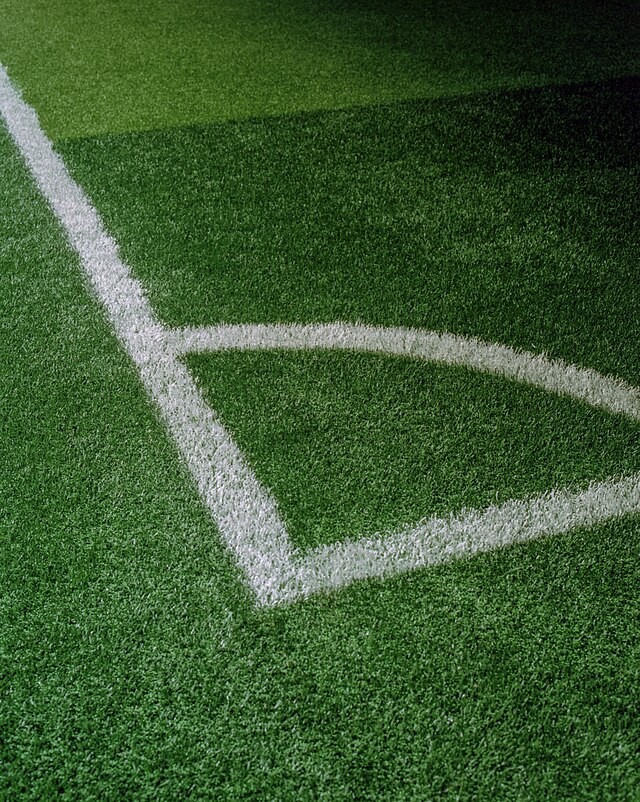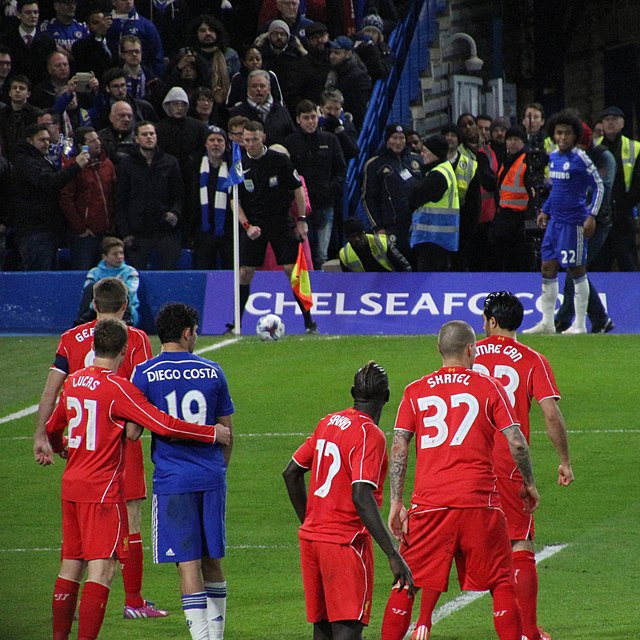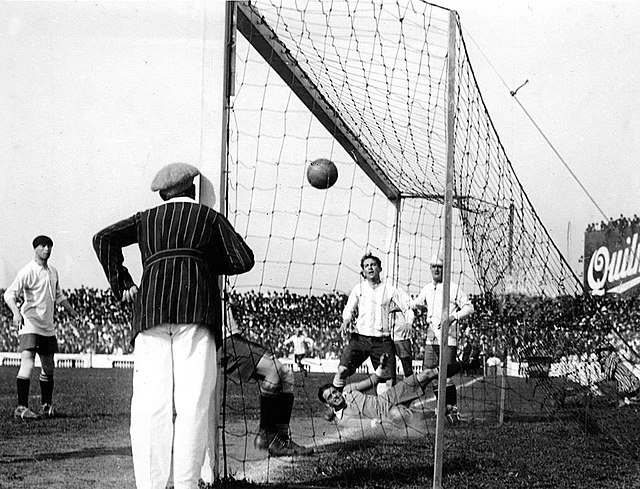Loading AI tools
Method of restarting play in association football From Wikipedia, the free encyclopedia
A corner kick, commonly known as a corner, is the method of restarting play in a game of association football when the ball goes out of play over the goal line, without a goal being scored and having last been touched by a member of the defending team. The kick is taken from the corner of the field of play nearest to the place where the ball crossed the goal line.



Corners are considered to be a reasonable goal-scoring opportunity for the attacking side, though not as much as a penalty kick or a direct free kick near the edge of the penalty area.
A corner kick that scores without being touched by another player is called an Olimpico goal,[1] or less commonly, Olympic goal.
A corner kick is awarded when the ball wholly crosses the goal line outside of the goal frame having been last touched by a member of the team defending that end of the pitch. For the purposes of this rule, it does not matter if this touch is deliberate; it is permissible to kick the ball at an opponent to win a corner kick.[citation needed]
A corner kick is also awarded instead of an own goal when the ball enters a team's goal, having been last touched by a member of the defending team, in the following rare situations:
The corner kick is taken from whichever corner was closer to the point where the ball went out of play.

If the kick is taken with a moving ball, or from the wrong place, the corner kick is retaken.[10]
Opposing players must retire the required distance as stated above. Failure to do so promptly may constitute misconduct and be punished by a yellow card.[11]
A player who excessively delays the restart of play is cautioned.[12]
It is an offence for the kicker to touch the ball a second time before it has been touched by another player; this is punishable by an indirect free kick to the defending team from where the offence occurred,[13] unless the second touch was also a more serious handling offence, in which case a direct free kick is awarded to the defending team.[10]


A common tactic is for several attackers to stand close in front of the goal, whereupon the corner taker crosses the ball for them to head into the goal.
The defending team may choose to form a wall of players in an attempt to force the ball to be played to an area which is more easily defended. However, this is not done often because defending players must remain at least 10 yards from the ball until it is in play.
The defending team also has the choice of whether to instruct a player to adopt a position beside one or both of the goalposts to provide protection to the goal in addition to the goalkeeper. The thinking behind placing a player beside a goalpost is that it means more of the goal area is protected and there is no loss in the ability to play an offside trap because offside does not apply for the first touch from a corner, and it compensates for a keeper's positioning and/or reach.
The defending team also has to decide how many players it needs to defend a corner. Teams may withdraw every player into a defensive area, however this diminishes the potential for a counter-attack if possession is regained, and as such, allows the attacking side to commit more players to attacking the goal. Withdrawing all players into a defensive area also means that if the ball is cleared from an initial cross, it is more than likely that the attacking team will regain possession of the ball and begin a new attack.
In situations where a set-piece, such as a corner, is awarded to a side trailing by a single goal at the closing stages of a match where conceding further is of minimal consequence (i.e. in a knockout tournament) a team may commit all their players, including their goalkeeper, to the attack.[citation needed]
Two popular strategies used for defending corners are called man marking and zonal marking. Man marking involves each defensive player at a corner being given an attacking player to defend, with their objective being to stop the attacking player from heading the ball. The other tactic, zonal marking, involves allocating each player to an area of the box to defend (their "zone"). The objective for players in zonal marking is to get to the ball first if it enters their zone and head it away from danger before an attacking player can reach it.
Rather than the kicker attempting a cross, an alternative strategy for the attacking team is the short corner. The ball is passed to a player close the kicker, to create a better angle of approach toward the goal.[citation needed]
Teams attempting to time-waste may keep the ball in the corner of the pitch for as long as possible rather than attempt an attack.[citation needed]

It is possible to score with a corner kick if sufficient swerve is given to the kick and/or if wind is blowing toward the goal. The goalkeeper is usually considered at fault if a goal is scored from a corner.[14]
This type of goal is called an Olympic goal or Olimpico goal. On 14 June 1924, the IFAB formally legalized scoring in this manner; the first such goal was scored on 2 October 1924 by Argentina's Cesáreo Onzari against Uruguay, who had just won the 1924 Olympic title.[15][16][14]
For decades, English speakers generally used the term Olympic goal. But the 21st century has seen the rise in the use of Olimpico goal, derived from the Spanish and Portuguese term gol olímpico widely used in Latin America.[15][16] Max Bretos has used it on Fox Soccer Channel in the United States, reflecting Latino influence on the sport's culture there. Virtually all reports of Megan Rapinoe's goal in the bronze medal match at the 2020 Tokyo Olympics referred to it as an Olimpico goal.[1]
Notable examples
Most methods of restarting the game do not permit the scoring of an own goal directly from the restart;[nb 1] if the ball enters the goal directly, a corner is awarded instead. This is the case for the kick-off,[33] goal kick,[nb 2] dropped ball,[nb 3] throw-in,[35] corner kick,[nb 2][39] and free kick (direct or indirect).[40] Such incidents are extremely rare, and in some cases require unusual or extraordinary circumstances in order to occur (for example, a ball from a corner kick would have to travel the entire length of the field and enter the kicker's own goal without being touched by any other player).
In a 1983–84 English Third Division match, Millwall were incorrectly credited with a goal against Wimbledon rather than a corner, when Wally Downes' free-kick backpass eluded an off-guard Dave Beasant.[41][42] In a 2002–03 FA Premier League match, Birmingham City scored against their local rivals Aston Villa when Olof Mellberg's throw-in backpass was missed by Villa goalkeeper Peter Enckelman, who reacted with dismay but later claimed he had made no contact and the goal should not have been awarded. His reaction may have persuaded referee David Elleray that Enckelman had grazed the ball; manager Graham Taylor suggested it showed he was unaware of the corner rule, a charge Enckelman denied.[43][44][45]


Under the original 1863 rules of the Football Association, a ball kicked behind the goal-line was treated similarly to present-day rugby: if an attacking player touched the ball down first, the attacking team was awarded a free-kick at goal (similar to a conversion in rugby), while if a defending player touched the ball down first, the defending team was awarded a goal-kick.[46] These rules were subsequently simplified, so that by 1867 a goal-kick was awarded in all circumstances, regardless of which team touched the ball.[47]
During this period, clubs around Sheffield played their own distinctive code of football. The laws promulgated in early March 1867 by the newly formed Sheffield Football Association contained a similar rule: a goal-kick was awarded whenever the ball went behind the goal-line, regardless of which team touched the ball.[48]
One problem with these early rules was mentioned at the 1867 FA meeting:[49]
Where one side was very much weaker than the other, a very great deal of time was wasted by players intentionally letting the ball go behind their own goal-line (in some instances kicking it there themselves) particularly in playing against time.
An early law providing for a throw-in from the corner flag had already been used by the Sheffield Mechanics' Football Club for the 1865–66 season:[50]
When the ball is in touch, the side that first touches it must bring it to the edge of the touch at the place where it went in, and throw it straight out at least six yards, and it must touch the ground before coming in contact with any player, except it be kicked out at the goal-sides, then it must be taken to the corner-flag and thrown in.
The corner-kick itself was suggested in a letter to the editor of the Sheffield Daily Telegraph published on 22 March 1867.[51] The author, writing under the pseudonym "Rouge", argued that the then-current rule was "a great inducement to foul and dishonourable play, for it is manifestly to the advantage of a defending side to allow the ball to pass their goal line, they having the great advantage or a free kick-off". Instead, Rouge suggested, "when the ball is kicked behind the goal-line, the players [should] run for touch, and the side winning the touch, kicks in from the nearest corner-flag".[51]
The corner-kick was introduced to Sheffield football the following year, as the result of a rule-change proposed by Norfolk F.C. The law, adopted in October 1868, ran:[52]
When the ball is kicked over the bar of the goal, it must be kicked-off by the side behind whose goal it went, within six yards from the limit of their goal. The side who thus kick the ball are entitled to a fair kick-off in whatever way they please; the opposite side not being allowed to approach within six yards of the ball. When the ball is kicked behind the goal line, a player of the opposite side to that which kicked it out, shall kick it in from the nearest corner-flag; no player to be allowed within six yards of the ball until kicked.
This Sheffield form of the corner-kick had two significant differences from today's version:
The Sheffield clubs would retain this form of the corner-kick rule until they adopted the FA's rules wholesale in 1877.
In 1872, the Sheffield Association successfully introduced the corner-kick into the Football Association's code. The new FA rule was identical to the Sheffield rule, as described above.[53]
The next year, 1873, the FA rule was rewritten, under a proposal by Great Marlow FC, to essentially its current form:[54]
The FA rule of 1873 stated:
When the ball is kicked behind the goal-line by one of the opposite side, it shall be kicked off by any one of the players behind whose goal line it went, within six yards of the nearest goal post; but if kicked behind by any one of the side whose goal line it is, a player of the opposite side shall kick it from the nearest corner flag-post. In either case no other player shall be allowed within six yards of the ball until kicked off.
The name "corner-kick" first appears in the laws of 1883.[55] Before this, the phrase "corner-flag kick" was used (1875). [56]
In 1874, the kick was allowed to be taken from within one yard of the corner-flag, rather than from the flag itself.[57]
Initially, all other players were forbidden to be within six yards of the ball at a corner-kick; this was altered to all opposing players in 1888.[58] In 1913 and 1914, the distance was increased from six yards to ten yards.[59][60][61] In 2006, the minimum distance was specified as ten yards from the corner area, rather than from the ball.[62]
In 1905, it was specified that the ball "must make a complete circuit or travel the distance of its circumference" before being in play.[63] In 1997, this requirement was eliminated: the ball became in play as soon as it was kicked and moved.[64] In 2016, it was specified that the ball must "clearly" move.[65]
When first introduced in 1872, the corner-kick was required to be taken from the corner-flag itself, which made it impossible for an attacking player to be in an offside position directly from a corner. In 1874, the kick was allowed to be taken up to one yard from the corner-flag, thus opening up the possibility of a player being in an offside position by being ahead of the ball. At the International Football Conference of December 1882, it was agreed that a player should not be offside from a corner-kick; this change was incorporated into the Laws of the Game in 1883.[55]
When it was first introduced in 1872, there was no restriction on scoring a goal directly from a corner-kick. In 1875, this was forbidden,[56] but it was subsequently legalised by the International Football Association Board (IFAB) meeting of 14 June 1924 with effect from for the following season, and is now referred to as an Olimpico goal.[15][16][66] In 1997, the laws were amended to remove the possibility of scoring an own goal directly from a corner kick.[67]
When initially introduced in 1872, there was no restriction on dribbling from a corner-kick. In 1875, this was changed: it was forbidden for a player to touch the ball again after taking a corner-kick, before the ball had been touched by another player.[56]
In 1924, this restriction was accidentally removed, as an unintended consequence of the law-change allowing a goal to be scored directly from a corner.[68] This possibility was exploited by Everton winger Sam Chedgzoy in a match against Arsenal on 15 November of that year.[69] At the end of November, the International Football Association Board issued emergency instructions that dribbling was once again forbidden.[70] The law was formally amended to prohibit dribbling at the next annual meeting of the Board, in 1925.[71][72]
In 1882, an indirect free-kick was awarded when the player taking the corner-kick touched the ball again before it had touched another player.[73]
In 1905, an indirect free-kick was awarded for any infringement at a corner-kick.[74]
These penalties were accidentally removed from the laws in 1924, as described above. In 1930, both penalties were reinstated.[75] In 1973, the remedy for infringements other than the double touch was changed to a retake.[76]
The one-yard quarter-circle pitch marking is first explicitly mentioned in the Laws of the Game in 1938, but appears in the diagram of the pitch as early as 1902.[77] In 1995, the Laws of the Game were updated to explicitly allow optional marks on the goal line 11 yards from the corner flag, at right angles to the goal-line, to aid the referee in enforcing the minimum distance from the corner kick.[78] In 2008, similar optional marks were permitted at right angles to the touch lines.[79] (In 1977, the Scottish FA had proposed an additional pitch-marking of a quarter-circle with a radius of 11 yards for this purpose, but the suggestion was rejected).[80]
In the early 1920s, some charity matches began using corner-kicks as a tie-breaker in order to avoid replays.[81] In response, the laws of the game were amended in 1923 to state explicitly that the goal was the only means of scoring, and that a match that ended with equal number of goals scored was drawn.[82] Despite this, the Dublin City Cup (until the 1960s) and Dublin and Belfast Inter-City Cup (in the 1940s) used corner count as a tiebreaker in knockout rounds.[83][84] The use of corner-kicks in this manner was never approved by the International Football Association Board, and in 1970 IFAB endorsed the penalty shoot-out as its approved method of breaking ties.[85]
This table includes only kicks from the corner flag awarded to the attacking team after the ball goes out of play over the goal line. For kicks awarded to the defending team, see the goal kick article.
| Date | Awarded when | Location of corner-kick | Minimum distance required (team-mates) | Minimum distance required (opponents) | Kicker may play ball again before it is touched by another player | Attacking goal may be scored from a corner-kick | Own goal may be scored from a corner-kick | Player may be offside from a corner-kick |
|---|---|---|---|---|---|---|---|---|
| 1863 | Never | — | ||||||
| 1872 | Ball last touched by a player on the defending team, and ball did not go out of play directly over the goal | From the corner-flag itself | 6 yards | 6 yards | Yes | Yes | Yes | No |
| 1873 | Ball last touched by a player on the defending team | |||||||
| 1874 | From within one yard of the corner-flag | Yes | ||||||
| 1875 | No | No | No | |||||
| 1883 | No | |||||||
| 1888 | None | |||||||
| 1913,1914[61] | 10 yards | |||||||
| 1924 (June) | Yes | Yes | Yes | |||||
| 1924 (November) | No | |||||||
| 1997 | No | |||||||
Seamless Wikipedia browsing. On steroids.
Every time you click a link to Wikipedia, Wiktionary or Wikiquote in your browser's search results, it will show the modern Wikiwand interface.
Wikiwand extension is a five stars, simple, with minimum permission required to keep your browsing private, safe and transparent.